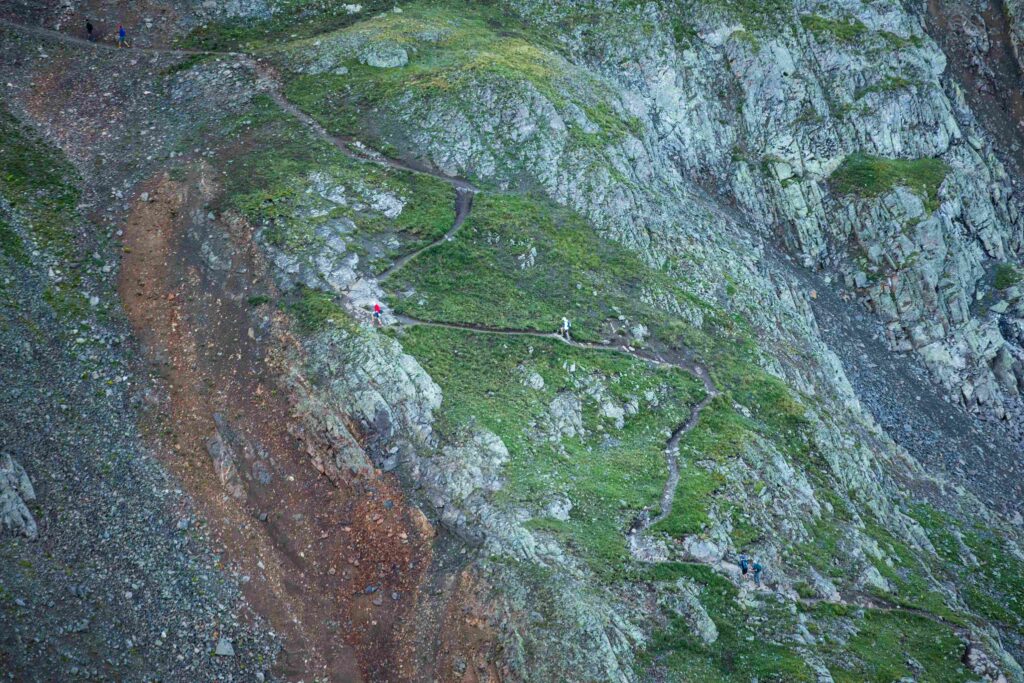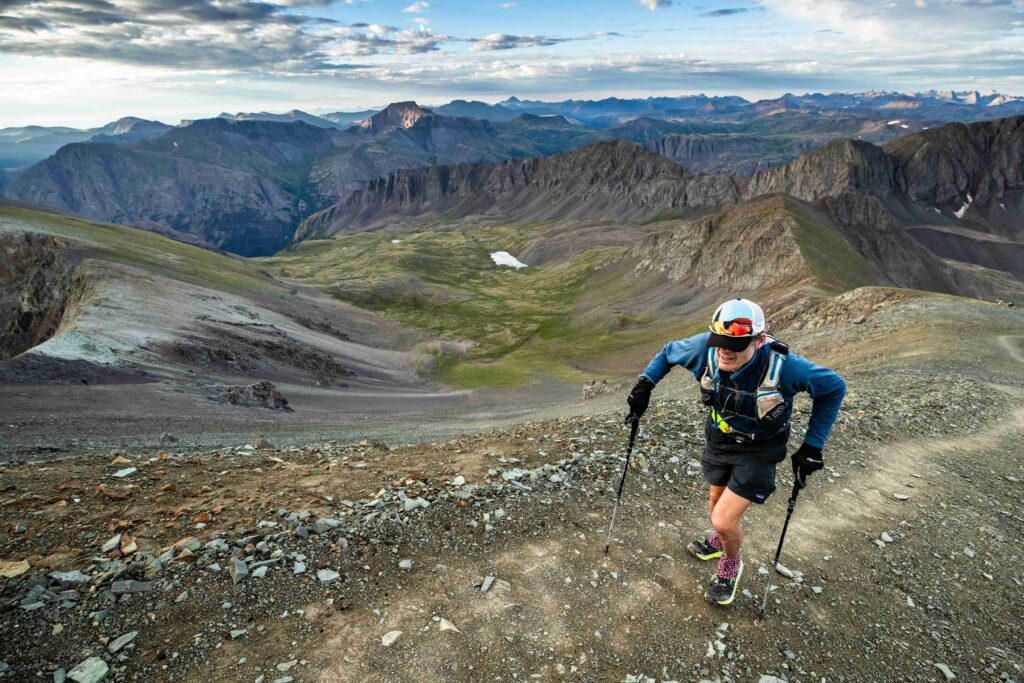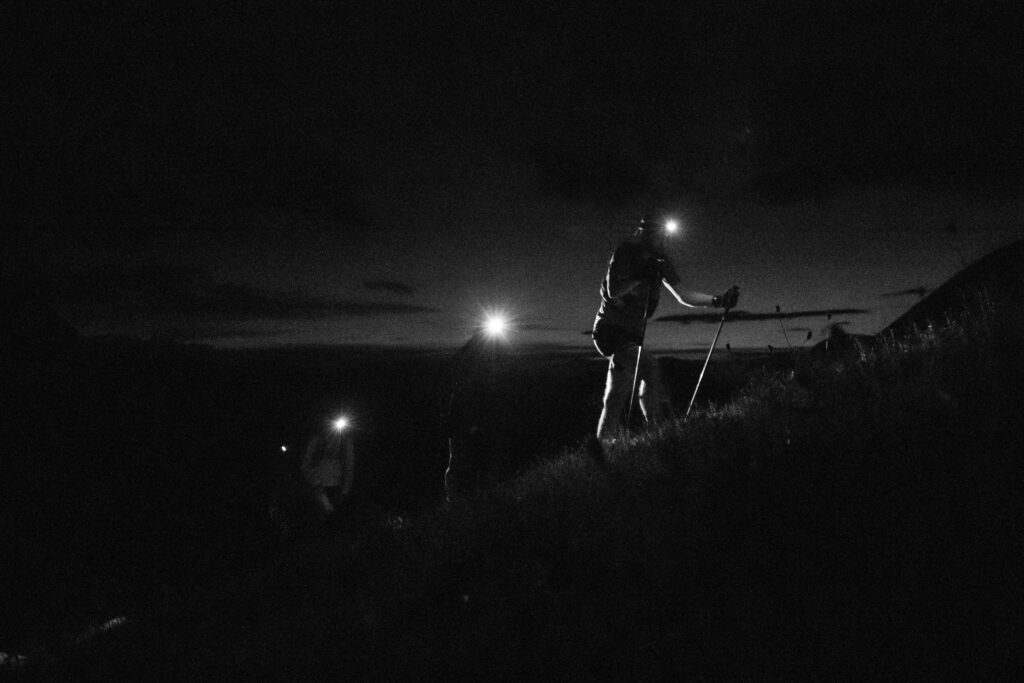Few races have captured the imagination like this rugged race through the San Juans.
Sane people define summer as June, July, and August. American ultrarunners demarcate the season with the Western States Endurance Run, the Hardrock Hundred Mile Endurance Run, and the Ultra Trail du Mont Blanc.
Established in 1974, Western States holds the title of oldest one-hundred-mile trail race in the world. And with a robust elite field, it’s like the Super Bowl of American ultrarunning. In terms of competition, States is only (arguably!) outdone by UTMB, the world’s biggest one-hundred-mile race and indisputably the most important European ultra.
So, what about Hardrock? Capped at 146 runners, this Colorado ultra is dwarfed by UTMB’s 10,000-plus participants (spread out over four races, but still, we’re talking magnitudes bigger). Furthermore, Hardrock usually boasts a handful of world-class runners. But with a rigged lottery favoring those who have done the event most since its inception in 1992, you may find more participants walking off the start line than running off it.
And yet, Hardrock—which starts at 6 am on Friday, July 14—captures the hearts, minds, and dreams of ultra fans around the U.S. and beyond.
“Hardrock is my family,” nine-time Hardrock finisher and two-time winner Darcy Piceu says. “Some of my closest friends are involved in the event. I love being in the San Juans, it’s the most beautiful place in Colorado.”
Piceu has made the six-plus-hour pilgrimage from Boulder to Silverton, Colorado, for the past three decades—the first half of which just to spectate and help out. She’s entered and finished the race nine times and won it twice.
Hardrock remains one of four events in the “Rocky Mountain Grand Slam,” along with Wasatch Front 100, Bear 100 Mile Endurance Run, Bighorn 100, and Leadville 100. Those others have lost much of their notoriety. When Piceu found out less than a week before the 2023 Hardrock that she’d gotten in off the waitlist, she was brought to tears.
Why does Hardrock endure?

Let’s face it: there are a lot of contrived race courses in this country. Out-and-backs, loops within loops, loops repeated five times in a row, our collective obsession with hitting certain distance milestones drives us into madness.
In the mountain west, there are also a fair number of races that over promise on their ruggedness (yes, I’m looking at you, Leadville).
Hardrock offers that elusive, perfect 100-mile circle, logically connecting the old mining towns of Silverton, Ouray, and Telluride over metaphorically and literally breathtaking terrain.
Ahhhh, it’s so aesthetically pleasing. And it’s gnarly as all get out.
“Hardrock has the San Juan mountains,” six-time starter and three-time finisher (including 2012 runner-up) Joe Grant says. “There’s a 14er. It hails, it snows, it’s super hot. It’s epic.”
Wending its way over singletrack, Jeep roads, and talus fields, the course climbs more than 33,000 feet over 100.5 miles for a total elevation change of 66,100 feet. In addition to the geography, runners must contend with the classic smorgasbord of Colorado’s summer alpine monsoon season conditions, ranging from heat to snow, hail to lightning.
Safe to say, Hardrock lives up to its “wild and tough” slogan. Simply completing the loop is a rewarding accomplishment, even for the best ultrarunners in the world. Grant has set records on the mythological Nolan’s 14, the 500-mile Colorado Trail, and the Colorado Fourteeners—a month-long self-powered effort. And yet he’s dropped out of Hardrock three times, the same number of times as he’s finished it.
The mythology of the course proceeds it.
Hardrock captured Grant’s attention in 2008, when 23-year-old Kyle Skaggs made the loop mostly shirtless, long blond hair half-heartedly held back from his face by a headband. He set the course record by three and a half hours, becoming the first person to break the 24-hour barrier.
“His race was relatable,” Grant says. “We were a similar age, and I dug his super minimal style. He embodied everything that I thought was cool about running in the mountains. Split shorts and a singlet with a single bottle tucked into his shorts—he executed the race in such a pure style, it had a huge impact on me.”
Hardrock was the only event Skaggs ever cared about running, he told IRunFar in 2018.
Grant entered the lottery for the 2011 Hardrock and lucked out. During the race, he got lost often, which Grant chalks up to a combination of not being very familiar with the course, fewer course markings, and far less technology.
“These elements have dumbed the event down over time,” Grant says.
GPS watches, online maps, improved course markings, and even a more firmly trodden trail from years of use may tamper the mystique of the event. But that seems to be largely counterbalanced by another prevailing trend: its ever-expanding myth.

Myth building is largely a function of time. And in the relatively new sport of ultrarunning, Hardrock has time on its side.
“The myth and lore surrounding the event is why people pay attention,” Grant says. “It’s like the Barkley Marathons. People lose their minds over it.”
If Hardrock is small, Barkley with 40 participants and a start date unknown to basically everyone else is even smaller. These quirky events remain compelling to people, Grant believes, because they are so deeply woven into the mythology of the sport.
Gordon Hardman wrote a letter in the November 1991 issue of UltraRunning magazine, soliciting help in creating a 100-mile race in the San Juans. Charlie Thorn and his friend John Cappis bit, and thanks to a good deal of trial and error the rest is history. Forty people (six women) toed the start line in 1992, and 18 (two women) made the round back to Silverton under their own power.
Since that inaugural run, many of the world’s best ultrarunners have tried their hand at the event. Both Grant and Piceu cite 2014 as a turning point. That year, a 26-year-old Catalan runner you may have heard of named Kilian Jornet won Hardrock on his first go.
“He brought along a lot of media,” Piceu says. “That’s when things started changing. The whole vibe of the race has changed.”
Jornet’s media and stamp of approval meant that suddenly people outside of the Hardrock bubble paid attention. Jornet flew over from Europe four more times to win Hardock—including a victory after dislocating his shoulder 13 miles into the run in 2017.
Hardrock is also GOAT-Courtney-Dauwalter-approved. Stomach issues forced Dauwalter to drop from Hardrock in 2021. (See, the event is hard, people! Even the mightiest succumb to its wrath!) But she returned for revenge and boy did she get it. Dauwalter shattered the course record in 2022, and she’s back this year to go for that CR in the opposite direction. (In another of its mythological eccentricities, Hardrock rotates directions every year.)
Diana Finkel, Scott Jurek, Krissy Moehl, David Horton, Anna Frost, François D’Haene—the list of legends cemented into Hardrock history goes on and on. Every year at the pre-run briefing, race director Dale Garland honors those with the most Hardrock finishes: Nancy Hamilton with 24 and Kirk Apt with 26.
Hardrock has 31 years of stories baked into its name. And 31 years of contending with the relentless progress of modernity.

Hardrock touts itself as a run, not a race. That underlying ethos overlaid with the commercialization and commodification of the sport collide in what can be equated to a volcanic event: ever-growing, and ever more dramatic.
“It’s both a race and a run,” Grant says. “Philosophically, the idea is to complete the loop. It’s less about competing against other people. The course is the challenge. That’s enough to have an adventure.”
Call Grant a purest—he probably would call himself that as well. As the sport continues to grow, paradoxically our longing for the past grows too.
Hardrock was born out of the curiosity of the human spirit—those runners toeing the line in 1992 were not sure the loop could be completed in one go. That central tenet remains fundamental to the event.
“I was drawn in by the badass mountain athletes,” Piceu says. “Hardrock is suited for people who are really comfortable in the mountains. That was really interesting to me. It’s more of a mountaineers race than a runner’s race.”
Runners do not cross a finish line. They kiss the Hardrock, a picture of a ram’s head painted on a large block of stone mining debris. At the “graduation ceremony”—otherwise known as an awards ceremony in common English—Garland honors every finisher, starting with last place.
“I freaking love that,” Piceu says. “Dale has a story about everyone who has finished. That’s what makes it an amazing community. The people who keep coming back, the people who have finished it. Hardrock would not be the same without those people.”
Hardrock is built upon community—quite literally.
“Volunteers run the show,” Grant says. “People work tirelessly and unselfishly to make the race happen. That’s the backbone of ultras. People are there to support out of passion and love for the sport. That’s part of the ethic of the event. You take and you give back.”
This year, for the third year in a row, Grant will captain the infamous Kroger’s Kanteen—an aid station precariously perched on a rocky-mountain pass at 13,000 feet. He’s carrying on the tradition of Roch Horton, who ran Hardrock 10 times before captaining the aid station 10 times.
Hardrock is a community event that opens itself up to the public—to a degree. And this is where the lava starts to seep over the sides. Sure, anyone who’s completed a Hardrock qualifier can enter the lottery. But the pool of entrants is relatively large and ever growing. Last year, 2,414 runners vied for 146 spots.
Unfortunately for the simplicity of writing this article, the lottery is a lot more complicated than that. Essentially, it’s two separate lotteries for those who have never run Hardrock, and for those who have. As you can imagine given the microscopic size of the run, the “never” application piles stack up a lot higher than the “finisher” piles. I’m really simplifying the math here, so bear with me. But if you’ve run Hardrock before, your chance of getting to run again is roughly about 30 percent. If you’ve never run Hardrock, your chance of toeing the line in Silverton is about three percent.
Yes, you read that correctly. You are at least ten times more likely to get into Hardrock if you’ve already run it. I personally believe Hardrock can do whatever it wants. If Hardrock wants to favor the “old timers” (who helped establish the event) over newcomers (who may include high caliber and diverse runners), that’s the event’s prerogative. It’s a free country. The more interesting question to me is: what is Hardrock trying to be?
“Hardrock is run like a grassroots event,” Grant says. “But it’s not grassroots in terms of its scope and reach.”
Are these seemingly diametrically opposed forces compatible? Can Hardrock be both a community event and an internationally acclaimed (cover your ears, Dale) race?
Hardrock sits between, well, a rock and a hard place. It remains rooted in tradition and an old-school mentality. But it thrives on the global stage. It straddles two worlds drifting ever further apart in our increasingly technologicalized and commercialized era. It’s in this liminal space that Hardock ruffles feathers, and also where it captures the imagination. It’s a taste of the past, accessible in the present. It’s an internationally revered race with the customs of a small-town run. It’s a look into a community, preserved at an arm’s length.
“Hardock has never been a mass participation event,” Grant says. “It’s very different than UTMB, which is trying to appeal to a big crowd and sell out their events. They’re trying to satisfy the demand. Hardock has chosen to keep the race small for a variety of reasons. They’re not putting out that their goal is mass participation. It’s imperfect, but it’s impossible to please everybody.”
And yet, “winning” or even landing on the podium of this non-race can catapult one’s career, as we’ve seen with the likes of Piceu and Grant. This attention and cachet is in and of itself not Hardock’s fault. But Garland does mindfully bring in some world-class competition each year with his mysterious “Dale’s picks”—five slots that Garland awards to unspecified people.
Hardrock will always remain small at the very least due to permitting and logistics. But it’s growing in other ways.
Hardrock will be livestreamed for the first time this year—with limitations. For one, cell service in the San Juans is abysmal. For another, there won’t be any birds-eye view drone coverage we’ve gotten so spoiled consuming at events like UTMB and States.
“The race is really different than it was 10, 15, 20 years ago,” Grant says. “But it’s still an impactful experience for those who participate.”
Hardrock is imperfect, and it’s constantly striving to be better. And it’s this ultra event, our ultimate challenge, that consumes our attention every July.

Nailed it. I think they could open up another 25-30 slots without too much impact to the trails, volunteers and the community, if the permitting allowed for it.
I believe Betsy Kalmeyer has the most women’s finishes with 21 after this year.
The lottery is certainly fair game for critiques like yours, but it isn’t accurate or fair to say the lottery is “rigged.” “Rigged” connotes that deception or dishonesty is involved; that just isn’t the case.